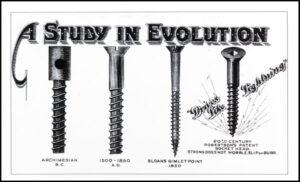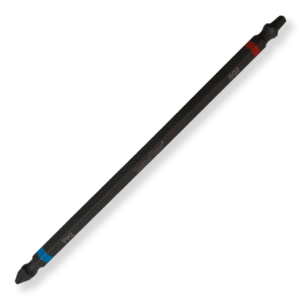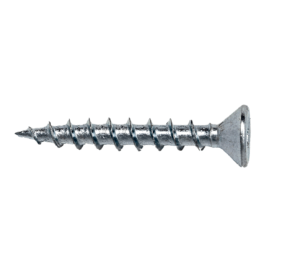Why You Should Use Robertson Screws (by an Electrician)
Buried in your 11-in-1 or your case of screwdriver bits is a curious little square bit. Personally, this bit seems to only work in situations where a Philips head tip won’t fit in a square screw and the extra channel for a flat head doesn’t quite grip. After cycling through every other bit, that square bit usually pulls through. But what is this bit and why should you use it? Enter the Robertson bit. The companion to the Robertson screw. The Robertson bit is a useful piece of kit to keep on hand as Robertson screws are extremely useful. Humble beginnings brought this screw design in conflict with a big name in history, and even though it might not be on the top of everyone’s list, you might find yourself with a new friend by the time you’re done reading.
History
The Robertson screw was invented in a small Canadian town by P.L. Robertson.  Robertson Manufacturing Company started in 1907, and by 1908 they were open for business. Their company history highlights that in 1908, Ford ordered enormous quantities of Robertson screws to be used in Model T production. The screw saved considerable time in the production process. But, in another chapter of Ford vs. The World, Henry Ford couldn’t convince Robertson to license the screw to him exclusively. Ford then limited usage and moved on to the Phillips head screw. Other companies would have considered this a death blow, but Robertson screws have survived to this day and were even named Canada’s bestselling product by 1981.
Robertson Manufacturing Company started in 1907, and by 1908 they were open for business. Their company history highlights that in 1908, Ford ordered enormous quantities of Robertson screws to be used in Model T production. The screw saved considerable time in the production process. But, in another chapter of Ford vs. The World, Henry Ford couldn’t convince Robertson to license the screw to him exclusively. Ford then limited usage and moved on to the Phillips head screw. Other companies would have considered this a death blow, but Robertson screws have survived to this day and were even named Canada’s bestselling product by 1981.
Common Uses
While the U.S. isn’t as familiar with the Robertson screw, they are a solid substitute for all fastening needs. The Robertson Screws company supplies their proprietary square drive screws as well as some other variations. On top of these drive styles, Robertson offers different head types such as flat, pan, and hex. There’s also the choice of different threads for whatever application you may need. The Robertson Screw company advertises that their screws can be used in any industry whether it be HVAC, electrical, residential construction, or woodworking.
 Most electricians will recognize combination screws, those with Robertson screw heads and Philips or slotted heads, which can be found on device terminals, circuit breaker terminals, enclosure screws, grounding screws, and probably a few other places if you start to have a look around the site. Double-ended bits are available, so you have access to a Robertson bit on one end and a Phillips on the other.
Most electricians will recognize combination screws, those with Robertson screw heads and Philips or slotted heads, which can be found on device terminals, circuit breaker terminals, enclosure screws, grounding screws, and probably a few other places if you start to have a look around the site. Double-ended bits are available, so you have access to a Robertson bit on one end and a Phillips on the other.
View All Rack-A-Tiers Robertson Bits
Why Use the Robertson Screw
If you’ve made it this far, you’re probably saying to yourself, “What’s the point? Why should I even consider the Robertson Screw?” The answer is simply torque. With every screw, you always reach a point where your screwdriver just can’t take anymore. This is the point you don’t want to be if you’ve still got half a screw left to drive in. The technical term for this slippage is “cam out”. The non-technical term for this is not safe for children.
Just the other day, I was trying to tighten a conduit body cover. The screws were the slotted-Phillips combo variety. The slot was too shallow for any torque with a flat head and the Phillips was utterly useless. Frustration ensued quite quickly. I’ve found myself in this situation with Phillips head screws often. Especially when using an impact. One little snag is all it takes for your bit to lose purchase and potentially strip the screw out.
This is the main downside of Phillips head screws. They were engineered in a different time. Their main purpose was to kick out the driver when the proper torque was reached. This was a great idea at one time and led to the screw’s popularity. However, higher torque applications require a different approach.
Robertson screws are advertised to be able to handle more torque before the dreaded cam out. The square design also allows for self-centring of the driver bit. You get a nice snug fit and ultimately less struggle. They are easier to use one-handed as well with such a design. It’s really a wonder that Robertson screws haven’t been more widely adopted. Especially in the United States. Maybe Henry Ford is to blame for that. We’ll chalk that down as a loss.
Robertson Screws vs Torx
Since we’ve all had our shared frustrations cursing Phillips and slotted head screws, what about other screw types? Torx-headed screws are sometimes seen at the job site but are generally more specialized. How do they stack up? As far as design goes, they offer the same function as Robertson screws: Fight the enemy that is cam out and get more torque (if the name wasn’t clear on that point). The main problem with Torx screws is finding the right bit. Is it a T10 or T25 or maybe a T30? The wrong bit could damage the screw. Torx screws are great for proper applications, but maybe not as widely used as other fasteners.
Hex-headed screws also offer a little more purchase than Phillips or slotted screws. But Torx screws were designed to replace both internal drive and external drive hex screws. Who knew there was such fierce competition between fasteners? Again, hex heads are great for special applications. They mimic the common nut and bolt to some degree, but the variation in sizes again disqualifies them from universal usage.
Buy Robertson Screws and Bits
 Looking to give Robertson Screws a try on your next project? Rack-A-Tiers carries a variety of flat, pan, and truss head Robertson Screws and Robertson bits so you can get everything you need in one place. Try out these ingenious and innovative fasteners on your next electrical, woodworking, or DIY project and experience the difference.
Looking to give Robertson Screws a try on your next project? Rack-A-Tiers carries a variety of flat, pan, and truss head Robertson Screws and Robertson bits so you can get everything you need in one place. Try out these ingenious and innovative fasteners on your next electrical, woodworking, or DIY project and experience the difference.
Conclusion
Use more Robertson Screws! Maybe you’re not convinced. That’s okay. At least keep your eyes open. The next time you see a square recess in your screws, don’t be afraid to switch to that square drive bit. If you haven’t really noticed them before, I hope you start to register them now. These aren’t just the chocolate screws vs the vanilla screws you’re used to. They have tangible benefits. You can take my word for it, or you can go screw for yourself.